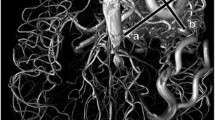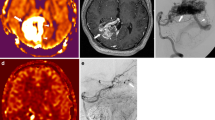Abstract
Of 86 patients with whose cerebral arteriovenous malformations (AVMs) were embolised in the period 1985–1990 29 were examined by high-field spin-echo (SE) magnetic resonance imaging (MRI) after endovascular therapy with gistoacryl-lipiodol. Embolisation-related changes in the nidus of the AVM and in the surrounding brain parenchyma were assessed. Results were compared with pretreatment MR and CT, and with follow-up angiograms in all patients. In accordance with angiographic findings, complete obliteration of pathological vessels was noted in 7 patients (24.1%) and partial occlusion in 22 (75.9%); small ischaemic infarcts were observed in 8 patients (27.6%) and extravascular deposits of blood breakdown products were seen in 3 (10.3%). MRI is a valuable noninvasive technique for assessing morphology and haemodynamics of cerebral AVMs before and after treatment. However, following embolotherapy, variable effects on signal intensity in vascular lumina caused by flowing blood, thrombosis and the embolisation agent have to be carefully analysed. To assess the exact site of histoacryl-lipiodol in embolised nidus territories or small areas of possible intracerebral hemorrhage, the time interval between endovascular therapy and MR examinations may have to be modified.
Similar content being viewed by others
References
Pelz DM, Fox AJ, Vinuela F, Drake CC, Ferguson GG (1988) Preoperative embolization of brain AVMs with isobutyl-2 cyanoacrylate. AJNR 9: 757–764
Debrun G, Fiñuela F, Fox A, Drake CG (1982) Embolization of cerebral arteriovenous malformations with bucrylate. J Neurosurg 56: 615–627
Eskridge JM (198) Interventional neuroradiology. Radiology 172: 991–1006
Luessenhop AJ, Presper JH (1975) Surgical embolization of cerebral arteriovenous malformations through internal carotid and vertebral arteries. J Neurosurg 42: 443–451
Luessenhop AJ, Rosa L (1984) Cerebral arteriovenous malformations. J Neurosurg 60: 14–22
Lanman TH, Martin NA, Vinters HV (1988) The pathology of encephalic arteriovenous malformations treated by prior embolotherapy. Neuroradiology 30: 1–10
Richling B (1989) The current state in endovascular treatment of cerebral arteriovenous malformations. In Aichner F et al. Neuroimaging II Fischer, Stuttgart, pp 309-315
Kucharczyk W, Lemme-Pleghos L, Uske A, Brant-Zawadzki M, Dooms G, Norman D (1985) Intracranial vascular malformations: MR and CT imaging. Radiology 156: 383–389
Crooks LE, Mill CM, Davis PL et al. (1982) Evaluation of cerebral and vascular abnormalities by NMR imaging: the effects of imaging parameters on contrast. Radiology 144: 843–852
Young IR, Bydder GM, Hall et al. (1983) NMR imaging in the diagnosis and management of intracranial angiomas. AJNR 4: 837–838
Bradley WG, Waluch V, Lai K et al. (1984) The appearance of rapidly flowing blood on magnetic resonance imaging. AJR 143: 1167–1174
Fishman MC, Naidich JB, Stein HL (1986) Vascular magnetic resonance imaging. Radiologic Clinics of North America 24: 485–501
Noorbehesht B, Fabrikant JI, Enzmann DR (1987) Size determination of supratentorial arteriovenous malformations by MR, CT and angio. Neuroradiology 29: 512–518
Smith HJ, Strother CM, Kikuchi Y, Duff T, Ramirez L, Merless A, Toutant S (1988) MR Imaging in the management of supratentorial intracranial AVMs. AJNR 9: 225–235
Viñuela F, Fox AJ (1983) Interventional neuroradiology and the management of arteriovenous malformations and fistulas. Neurol Clin 1: 131–154
Jabour BA, Dion JE, Lufkin R et al. (1989) Neurovascular lesions and endovascular therapy: the role of MR: Neuroradiology 31: 341–345
Salomonowitz E, Gottlob R, Castañeda-Zuñiga W, Amplatz K (1983) Work in progress: transcatheter embolization with cyanoacrylate and nitrocellulose. Radiology 149: 445–448
Gomori JM, Grossman RI, Goldberg HI, Zimmerman RA, Bilaniuk LT (1985) Intracranial hematomas: imaging by high-field MR. Radiology 157: 87–93
Gomori JM, Grossman RI (1988) Mechanisms responsible for the MR appearance and evolution of intracranial hemorrhage. Radiographics 8: 427–440
Brooks RA, Di Chiro G, Patronas N (1989) MR imaging of cerebral hematomas at different field strengths: theory and applications. J Comput Assist Tomogr 13: 194–206
Macchi PJ, Grossman RI, Gomori JM, Goldberg HI, Zimmerman RA, Bilaniuk LT (1986) High field MR imaging of cerebral venous thrombosis. J Comput Assist Tomogr 10: 10–15
Prayer L, Wimberger D, Stiglbauer R et al. Hemorrhage in intracerebral arteriovenous malformations: detection in MR imaging and comparison with clinical history. Neuroradiology (in press)
Nadel L, Braun IF, Kraft KA, Fatouros PP, Laine FJ (1990) Intracranial vascular abnormalities: values of MR phase imaging to distinguish thrombus from flowing blood. AJNR 11: 1133–1140
Edelman RR, Wentz KU, Mattle HP et al. (1989) Intracerebral arteriovenous malformations: evaluation with selective MR angiography and venography. Radiology 173: 831–837
Marchal G, Bosmans H, Van Frayenhoven L, Wilms G, Van Hecke P, Plets C, Baert AL (1990) Intracranial vascular lesions: optimization and clinical evaluation of three-dimensional time-of flight MR angiography. Radiology 175: 443–448
Author information
Authors and Affiliations
Additional information
Offprint requests to: L. Prayer
Rights and permissions
About this article
Cite this article
Prayer, L., Wimberger, D., Kramer, J. et al. MRI — a noninvasive tool for evaluating therapeutic embolisation of cerebral arteriovenous malformations. Eur. Radiol. 1, 51–57 (1991). https://doi.org/10.1007/BF00540104
Issue Date:
DOI: https://doi.org/10.1007/BF00540104




